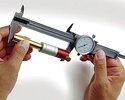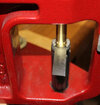Saluki91
Member
I have hit a wall with setting up my .308 Forster FL sizing die. Hopefully someone can steer me down the right path. My process is outlined below:
1 - Using my Hornady headspace comparator (anvil #4 for .308), I measured a piece of fired brass (spent primer removed). This provided a measurement of 1.165".
2 - I want to size my brass to 1.163"... size back 2 thou.
3 - I screw my Forster FL sizing die down to the shell pate, then back off a smidge (less than1/8th of a turn).
4 - I lube and size another piece of fired brass, remove the case lube, and measure to compare... no change.
5 - Repeat with the die screwed down slightly - no change.
6 - Continue to repeat step 4 with incremental moves towards the shell plate - no changes.
7 - Repeat with the die screwed all the way down, and a bit of cam-over... no change.
I thought I understood this process, but I clearly missed something (or some things).
Any suggestions?
Thanks!
1 - Using my Hornady headspace comparator (anvil #4 for .308), I measured a piece of fired brass (spent primer removed). This provided a measurement of 1.165".
2 - I want to size my brass to 1.163"... size back 2 thou.
3 - I screw my Forster FL sizing die down to the shell pate, then back off a smidge (less than1/8th of a turn).
4 - I lube and size another piece of fired brass, remove the case lube, and measure to compare... no change.
5 - Repeat with the die screwed down slightly - no change.
6 - Continue to repeat step 4 with incremental moves towards the shell plate - no changes.
7 - Repeat with the die screwed all the way down, and a bit of cam-over... no change.
I thought I understood this process, but I clearly missed something (or some things).
Any suggestions?
Thanks!




